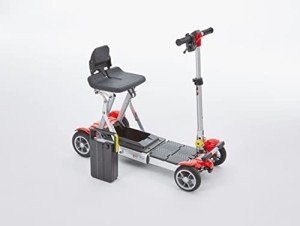7 Simple Changes That'll Make A Big Difference In Your Portable Mobility Scooters
Portable Mobility Scooters: Enhancing Freedom and Independence
As the world significantly moves towards inclusivity and ease of access, portable mobility scooters have actually become an advanced service for people with mobility obstacles. These compact, easy-to-transport scooters are designed to empower users with the ability to browse their environments with confidence and ease. In this article, we will check out the characteristics, benefits, and factors to consider when going with a portable mobility scooter, supported by tables and FAQs to supply a detailed summary.
Understanding Portable Mobility Scooters
Portable mobility scooters are lightweight, battery-operated cars that provide an alternative mode of transport for those with restricted mobility. Assembled using long lasting materials, they are particularly engineered to be lightweight and compact to assist in simple transport in vehicles or on public transport.
Key Features of Portable Mobility Scooters
Function
Description
Weight Capacity
A lot of scooters can support users weighing in between 250 to 500 lbs
Battery Life
Normal series of 10 to 30 miles per charge
Speed
Usually runs between 4 to 8 mph
Turning Radius
Varies from 32 to 60 inches, making them suitable for indoor use
Foldability
Many designs can be quickly folded for transport
Wheels
Generally geared up with either strong or pneumatic tires
Portable mobility scooters are perfect for both indoor and outdoor use, offering stability and ease of movement.
Advantages of Portable Mobility Scooters
Enhanced Freedom: Users can engage in activities that were formerly tough, such as shopping and mingling, therefore enhancing general quality of life.
Transportation Convenience: Many portable scooters can be easily dismantled or folded, permitting users to carry them in automobiles, vans, or public transportation.
Economical: Compared to powered wheelchairs, portable scooters are often more economical, providing a cost-effective solution.
User-Friendly Design: Most models feature instinctive controls, making them simple to operate for people of any ages.
Variety of Options: With various brand names and models on the market, possible users can pick scooters that match their specific requirements— ranging from off-road usage to compact indoor alternatives.
Crucial Considerations When Choosing a Portable Mobility Scooter
- Weight and Portability: Assess the weight of the scooter itself and its components. Lighter designs are usually easier to transfer.
- Battery Life and Range: Consider how far you require to travel on a single charge. If you anticipate long journeys, a scooter with an extended battery life is crucial.
- Size and Dimensions: Measure where you'll save the scooter and guarantee it fits easily in your automobile or home.
- Convenience Features: Look for scooters with adjustable seats, armrests, and other ergonomic features for included convenience throughout usage.
- Surface Compatibility: If you prepare to utilize the scooter outdoors, ensure it can manage various terrains (e.g., gravel, turf) with ease.
Factor to consider
Value
Weight & & Portability
Impacts ease of transport and storage.
Battery Life
Identifies variety and liberty to check out.
Size
Important for storage and maneuverability.
Convenience Features
Boosts the total user experience.
Surface Compatibility
Guarantees adaptability in outdoor conditions.
Regularly Asked Questions (FAQs)
1. How fast can a portable mobility scooter go?
Most portable mobility scooters can reach speeds between 4 to 8 miles per hour. However, foldable travel scooters may vary based on the model and the weight of the user.
2. Do portable mobility scooters require a license or registration?
In many nations, portable mobility scooters do not require a driver's license or registration, however it's important to examine regional policies.
3. What is the common cost series of portable mobility scooters?
Costs typically range from ₤ 600 to ₤ 3,000 or more, depending on features, brand name, and requirements.
4. Can portable mobility scooters be used on public transportation?
Yes, lots of public transport systems accommodate portable mobility scooters, but it's advisable to inspect in advance regarding policy information and space restrictions.
5. What are the upkeep requirements?
Routine upkeep includes battery checks, tire evaluations, and keeping the scooter tidy. It's recommended to speak with the user manual for particular maintenance guidelines for your model.
Portable mobility scooters have actually become a lifeline for many individuals seeking independence and mobility in their daily lives. Their convenience, ease of usage, and variety of available designs enable users to choose the perfect scooter to fit their way of life.
For anyone considering purchasing a portable mobility scooter, it's important to assess personal needs carefully and explore different alternatives on the market. With the best choice, these scooters can substantially improve mobility and help with a more active way of life, eventually causing enhanced health and wellness.
By comprehending the functions and elements associated with choosing a portable mobility scooter, users can take the very first step towards claiming their freedom once again. Whether for running errands, taking pleasure in the outdoors, or merely moving the home, portable mobility scooters redefine what it means to stay active and participated in life.
